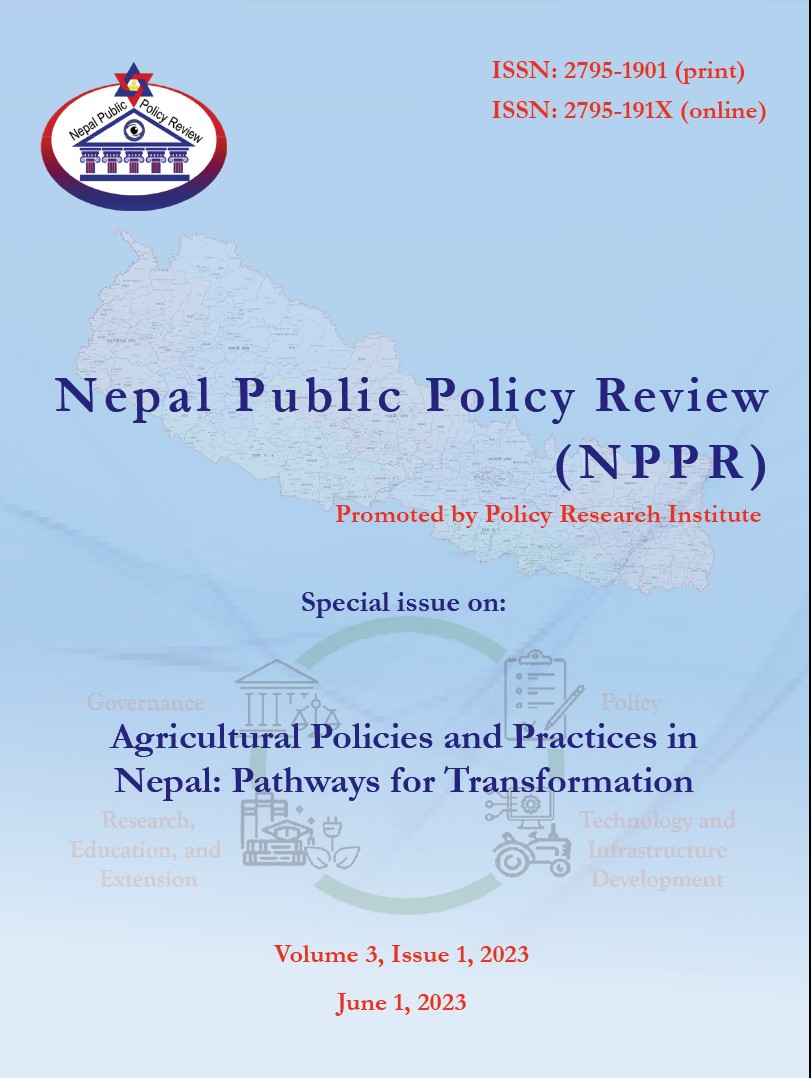Cooperatives as Pillar of Economy to Improve Agriculture Production and Marketing
DOI:
https://doi.org/10.59552/nppr.v3i1.61Keywords:
Cooperatives, agriculture production, marketing, cooperative movement, government support, policy intervention, capacity-building, commercialization, agro-products, credit, sustainable developmentAbstract
This paper focuses on the important role played by cooperatives in agriculture production and marketing in Nepal. The paper evaluates the role of cooperatives, their contribution to agriculture, current policies that have paved the way for development within the agriculture and cooperative sectors and recommendations for improving agriculture production and marketing. The methodology employed includes a review of existing literature on agriculture and cooperative policies, as well as discussions with key informants in the cooperative movement. The study highlights the need for support from government and non-government agencies to improve the service of agricultural cooperatives in various ways, particularly through policy intervention. The paper provides policy recommendations for the future, including the need for improved coordination between government agencies and cooperatives, capacity-building programs, commercialization of agro-products, ways of increasing agro-productivity and capacity-building for cooperative leaders, and better access to credit and markets. Overall, the study underscores the importance of cooperatives in the sustainable development of the agriculture sector in Nepal.
References
Basnet, B., & Pandey, K. (2018). Smallholder farming systems and rural livelihoods in the mid-hills of Nepal. Journal of Mountain Science, 15(7), 1444-1454.
Basnyat, J. (2022). Nepal's 'spray and pray' approach to agriculture. Nepali Times. Retrieved December 21, 2022, Retrieved from https://www.nepalitimes.com/opinion/nepals-spray-and-pray-approach-to-agriculture
Central Bureau of Statistics. (2019). Statistical Year Book of Nepal 2019. Central Bureau of Statistics.
Deshar, B. D. (2013). An Overview of Agricultural Degradation in Nepal and its Impact on Economy and Environment. Ripublication. Retrieved December 20, 2022, from https://www.ripublication.com/gjesd/gjesdv3n1_01.pdf
Fiscal Year 2020/2021. Ministry of Agriculture and Livestock, Kathmandu, Nepal.
Food and Agriculture Organization (FAO). (n.d.). Nepal at a glance | FAO in Nepal. Retrieved from https://www.fao.org/nepal/fao-in-nepal/nepal-at-a-glance/ru
Ghimire, S. R. (2009). Environmental Concern in Nepalese Agriculture. Journal of Agriculture and Environment, 9, 41–45.
Government of Nepal. (2019). Nepal Agriculture Policy 2019. Retrieved from https://moald.gov.np/storage/app/uploads/public/5db/802/096/5db8020963edc437146714.pdf
Gupta, A. (2022). Key highlights of budget 2022-23. Nepal Economic Forum. Retrieved December 31, 2022, from https://nepaleconomicforum.org/key-highlights-of-budget-2022-23
Himalayan Research Group. (2012). Smallholder Farming in Nepal: Opportunities and Challenges. International Journal of Agriculture and Biology. Retrieved from https://www.fspublishers.org/published_papers/17479_..pdf.
International Center for Integrated Mountain Development. (2017). Nepal Seed and Planting Material System Assessment.
Retrieved from https://www.icimod.org/resource/nepal-seed-and-planting-material system-assessment.
International Labour Organization (ILO). (2018). Cooperative Market Study: Enhancing Competitiveness of Agriculture Products in Nepal. International Labour Organization. Retrieved from https://www.ilo.org/wcmsp5/groups/public/---asia/---ro-bangkok/---ilo-kathmandu/documents/publication/wcms_628642.pdf.
International Labour Organization and National Cooperatives Federation of Nepal. (2018). Cooperative Market Study: Enhancing Competitiveness of Agriculture Products in Nepal. Retrieved from https://npc.gov.np/images/category/Enhancing_the_competitive_strength_of_the_nepalese_agricultural_produces1.pdf.
Kaini, B. R. (2020). Five policies for Agriculture. My Republica. Retrieved from https://myrepublica.nagariknetwork.com/news/five-policies-for-agriculture/.
Kathiwada, H. (2014). Role of Cooperatives in Rural Development: Lessons from Nepal. Asian Journal of Agriculture and Development, 11(2), 57-72.
Khadka, S. (2022). About 3,000 youths leave Nepal every day. My Republica. Retrieved from https://myrepublica.nagariknetwork.com/news/about-3000-youths-go-abroad-every-day/.
Ministry of Agriculture and Livestock Development (MoALD). (2021). Agricultural Cooperatives in Nepal. Retrieved from https://www.cooperativesnepal.gov.np/uploads/PDF/Annual_Report_2076-77_ENG.pdf.
Ministry of Agriculture and Livestock Development [MoALD]. (2021). Agriculture development strategy 2019-2030. Kathmandu, Nepal: MoALD.
Ministry of Finance (MoF). (2019). Red Book. Fiscal Year 2019/2020. Ministry of Finance, Kathmandu, Nepal.
Ministry of Finance (MoF). (2021). Budget Speech of Fiscal Year 2078/79. Retrieved fromhttps://www.mof.gov.np/uploads/document/file/Budget_Speech_in_English_2078-79.pdf.
Ministry of Finance (MoF). (2021). Red Book. Fiscal Year 2021/2022. Ministry of Finance, Kathmandu, Nepal.
Mishra, A. K., Dubey, A., Singh, R. K., & Kumar, A. (2017). Impact of Agricultural Insurance on Agricultural Productivity and Risk Behaviour: Evidence from India. Indian Journal of Agricultural Economics, 72(4), 468-481.
MoALD. (2019). Yearly Development Program for Federal, Province and Local Level. Fiscal Year 2019/2020. Ministry of Agriculture and Livestock, Kathmandu, Nepal.
MoALD. (2020). Statistical information on Nepalese agriculture 2077/78 (2020/21). Ministry of Agriculture and Livestock Development, Kathmandu, Nepal.
National Agriculture Policy (NAP). (2004). Ministry of Agriculture and Cooperatives, Government of Nepal. Retrieved from https://extwprlegs1.fao.org/docs/pdf/nep54300.pdf.
National Cooperative Federation of Nepal (NCF). (2021). Modern Processing Plants and Storage Facilities. Retrieved from http://ncf.org.np/modern-processing-plants-and-storage-facilities/.
National Cooperatives Development Board (NCDB). (2021). Collection Center and Transportation. Retrieved from https://www.ncdbnepal.gov.np/collection-center-and-transportation/.
National Planning Commission (NPC). (2019). Fifteenth Plan (Fiscal year 2076/77 - 2080/81) - A Draft Report. National Planning Commission, Kathmandu, Nepal.
Nepal Agricultural Cooperative Central Federation (2018). Impact Study of Agricultural Cooperatives in Nepal.
Nepal Rastra Bank (NRB). (2018). Demographic, Social, Economic and Financial Status of Nepal (Province Profile). Department of Investigation, Nepal Rastra Bank, Nepal.
Sapkota, S. (2021). Opinion: What's in the Agriculture Budget. The Kathmandu Post. Retrieved December 31, 2022, from https://kathmandupost.com/columns/2021/06/15/what-s-in-the-agriculture-budget.
Shrestha, R. B., Ferrand, P., Penunia, E., Dave, M., & Ali, Y. (n.d.). United Nations Decade of Family Farming 2019-2028: Regional Action Plan to Implement the UNDFF for Achieving the SDGs in South Asia. Asian Farmer. Retrieved from https://asianfarmers.org/wp-content/uploads/2008/10/UNDFF_20192028_Regional_Action_Plan_to_Implement_the_UNDFF_for_Achieving_the_SDGs_in_South_Asia.pdf.
Shrestha, S. K., & Adhikari, B. (2019). The Role of Credit in the Adoption of Modern Farm Technologies and Agricultural Productivity in Nepal. Agricultural Economics Research Review, 32(2), 209-217.
Trade Map. (2021). International trade statistics. Retrieved from https://www.trademap.org/.
World Bank. (2013). Financial Inclusion in Nepal: Access, Usage and Challenges. Retrieved from https://www.worldbank.org/en/country/nepal/publication/financial-inclusion-in-nepal-access-usage-and-challenges.
Additional Files
Published
How to Cite
Issue
Section
License
Copyright (c) 2023 Rudra Bhattarai, Manashi Pandit

This work is licensed under a Creative Commons Attribution-NonCommercial 4.0 International License.






